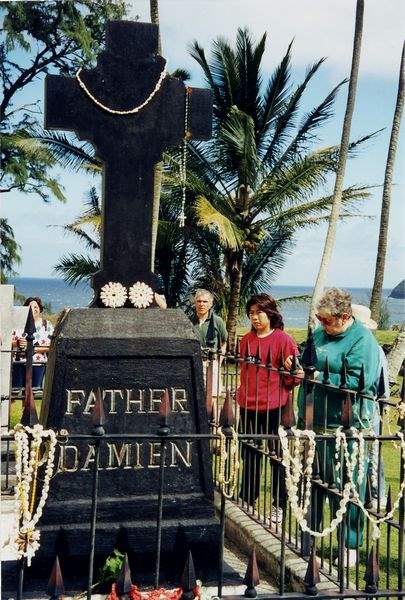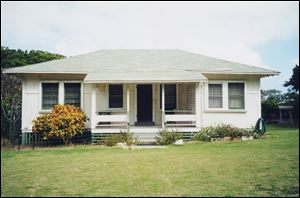
The spirit triumphs at former leper colony
10/6/2001
A monument for Father Damien is found on Kalaupapa, Hawaii, where, from 1866 to 1969, people diagnosed with leprosy were taken to live.
powell
MOLOKAI, HAWAII - As I waited for the five-seat inter-island plane to return me to Honolulu, Kuulei Bell, a woman in a bright straw hat and pheasant feather garland, using a walker, arrived at the one-room terminal at Kalaupapa here.
At about the same time, Patrick Kaluola, a maintenance worker at Kalaupapa National Historical Park, showed up, carrying a guitar case. He was on his way home to the Big Island for the weekend.
The two immediately engaged in friendly conversation. Within minutes, he was playing the guitar and she was singing at the top of her voice. It was joyful, a spontaneous interlude that summarizes nicely the spirit of Kalaupapa and the sweet lesson learned on a four-hour tour of the former leper colony.

This house is typical of those built for patients in the village.
Kalaupapa is the tiny town on an isolated peninsula where, from 1866 to 1969, people diagnosed with leprosy were taken to live. Like most visitors, I had traveled there from Hawaii's more romantic destinations: Waikiki on Oahu and Lahaina on Maui - prepared for a sad visit.
Such thoughts quickly dissipate in the contentment and genuine happiness of Kalaupapa residents like Mrs. Bell, Richard Marks, and Barbara Marks, his sister-in-law. “Patient,” not leper, is the proper way to refer to them and others exiled there by the Hawaiian Department of Health. From 1866 until 1969, when the law was rescinded, 8,000 people were taken to the place Robert Lewis Stevenson called “the painful shore.”
Today 43 patients, age 59 to 97, remain in the small village, but now by choice.
Their homes belong to the state, but they are given lifetime possession. There they enjoy familiar surroundings and the company of friends. Medications for leprosy - now called Hansen's disease - are dispensed in the village, where supplies are delivered by mule, plane, and barge.
Kalaupapa is jointly managed by the Hawaii state department of health and the National Park Service.

A monument for Father Damien is found on Kalaupapa, Hawaii, where, from 1866 to 1969, people diagnosed with leprosy were taken to live.
At the Visitors Center, Barbara Marks, 69, a patient since she was 15, explained her contentment:
“It's such a beautiful place. I have been here most of my life. I go to Honolulu to see my mother, but I don't like it on the outside. I can't wait to get back home,” she said with a broad, sincere smile.
She works at the center and keeps busy tending her orchids and roses and attending St. Francis Catholic Church, one of three churches in the village.
Mrs. Marks recalls the first signs of the dreaded illness when she was 12 - lumps and white scars on her skin. Today, the only visible signs of the disease, which affects nerves, skin, and eyes, are two fingers which are taped.
At 71, Mr. Marks is the spark plug who keeps the community alive. He's a one-man band who operates Damien Tours and has been a patient since 1956. He tells visitors that he is also the sheriff, the mayor, and historian.
He leaves few questions unanswered in his narration while driving a rusting yellow school bus over a bumpy road to the park overlooking the bay, where lepers once were left to fend for themselves.
The site, with a clear view of the majestic Waikolo Valley, where early patients found shelter in fishermen's huts, is a beautiful but bittersweet setting for a lunch stop.
Mr. Marks' stories of life at Kalaupapa are seasoned with bitterness over the health department's cruel relocation of patients (some of his relatives, including Barbara Marks, also lived there).
He warns bus passengers not to wander off at any of the stops and not to take pictures of patients. “This is not like the rest of Hawaii,” he says. What visitors see is what Mr. Marks thinks they should see. They are not permitted to go into the general store, the post office, or to Elaine's Place, the town's social center.
At one house, he stops to feed a chained black dog, explaining that another responsibility is the care and relocation of pets for patients who have died.
Pets have always given patients something to care for in the absence of children, who never have been allowed in the settlement. Even under newer laws, no one under 16 is allowed to visit. Pregnant women were taken from Kalaupapa in their seventh month to have their babies in Honolulu. The mother would return; the baby would be raised on the outside.
Mr. Marks and his wife, Gloria, met and married at Kalaupapa, and had four children. “We lost one, but the others are all over the country. My son is in Las Vegas and has a big job,” he said.
“Why would I want to move from here? My children are all grown now and this is our home,” he said.
“Sure, I have a daughter,” Mrs. Bell said on the plane ride to Honolulu. “She lives in Honolulu and I plan to see her.” Mrs. Bell was keeping an appointment for a six-month cancer check-up; she would return home two days later. “If I could, I would come home right after the appointment, but I have to wait for a plane,” said the patient who was taken to the settlement at age 6. She is Kalaupapa's postmistress.
Not surprisingly, the tour revealed a good share of heart-rending sights. The bus passed large cemeteries with many unmarked graves. In the immaculately groomed neighborhoods, several houses with shades drawn and no sign of life were clues the former residents had died.
While much of Kalaupapa's history may be unknown to the average visitor to Hawaii, the name and legends surrounding Father Damien, the settlement's most revered resident, are more familiar.
The tour schedule allows considerable time at the grave of the beloved Belgian priest who contracted leprosy working with patients, and at the church that was nearly completed when he died at 49. Mr. Marks informs visitors that Father Damien traveled to the Hawaiian islands as a carpenter to build churches, not to care for the lepers.
Mary Alice Powell is a retired Blade food editor.